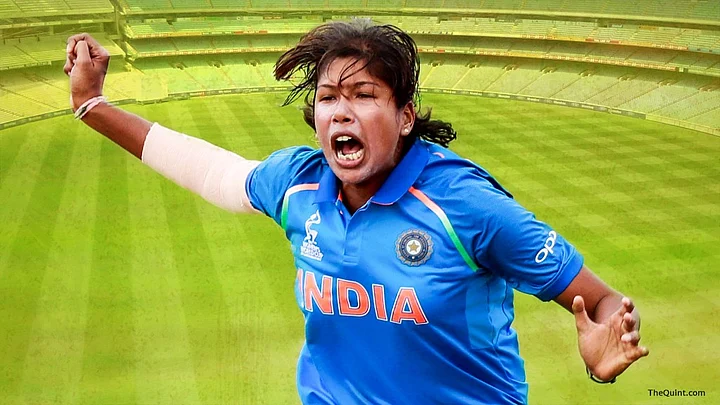(On Jhulam Goswami’s 38th birthday, The Quint is republishing this piece from its archives. Originally published on 24 July 2017.)
Until the ICC Women’s World Cup in 2017, not many would have known the Indian women’s team beyond two names – Mithali Raj and Jhulan Goswami – the two cornerstones that stand as imposing figures in the top echelons of world cricket, and also the two, in their late thirties, probably played their last World Cup two years back.
Captain Raj lived up to her reputation of being the most consistent Indian batter in the tournament (409 runs), which is why a lot has been written and spoken of her by the media.
On the other hand, bowler Goswami, who is the highest wicket taker in the history of women’s ODI cricket, came into her own during the business end of the tournament.
She recorded impressive figures of 3/23 in the final at Lord’s against England.
Therefore, her journey from a small district in West Bengal to the 22 yards makes for an inspirational recall.
Many of us are aware of Virat Kohli’s two biggest national feats. The India captain received the Arjuna award in 2013, and most recently, the Padma Shri award in 2017. However, not many cricket fans would be aware that Jhulan Goswami too has both of these coveted awards in her bag.
Let’s return to where it all began.
Humble Beginning in the Backwaters of Cricket
Goswami was born on 25 November 1982 in West Bengal’s Chakdaha town. Before deciding on cricket as her career, Goswami, much like most people living in Bengal, was a football fanatic.
Hailing from a town which didn’t have any cricket facilities, Goswami endured the rough and tumble of traveling to Kolkata everyday for early morning practice. Defying her family’s disapproval of her cricketing dreams, she would travel 58 km daily, in a crowded local train, to become what she is today.
In most of her interviews, Goswami fondly recalls how she forged a relationship with the game. Witnessing the 1997 World Cup final at the Eden Gardens live, and watching the then greats like Belinda Clark and Debbie Hockley play from close quarters, Goswami vowed to don the blue jersey one day.
As a teenager, the local guys in her neighbourhood mocked the budding pacer for bowling too slowly. The young girl welcomed the mockery as constructive criticism and began to work on her speed. From a light tennis ball, she started practising with deuce balls in Kolkata which gradually bettered her speed and a few years down the line, in 2006-07, she became the fastest bowler in the world with a speed of 120 km/h.
A Dream Materialised
After years of impressive performances in the domestic circuit for Bengal, Jhulan finally stormed into the dream world of international cricket in 2002. Her express pace, immaculate line and length, and ability to destroy the opposition single-handedly was what set her apart from others.
She was all of 19 when she played her first ODI game for India, against England in Chennai. In the seven overs that she bowled, she conceded 15 runs and scalped two wickets, and with that, cemented her place in the squad.
During her 15 years in international cricket, she has played 164 one-dayers in which she has picked up 195 wickets. Goswami took the wicket of South Africa’s Raisibe Ntozakhe in an ODI in May this year to claim her 181st victim, breaking Australia’s Cathryn Fitzpatrick’s record of 180 wickets from 109 matches.
She also holds the bragging rights for four 4-wicket hauls and two 5-wicket hauls in the same format.
In whites, a format largely unpopular and seasonal in women’s cricket, she has played 10 Tests and grabbed 40 wickets, a tally which includes two 4-wicket hauls, three 5-wicket hauls and also a solitary 10-wicket haul.
Goswami led India to a historic first Test series win in England in 2006, with astounding figures of 13-4-33-5 and 36.2-21-45-5, after which she was made the ODI captain from 2008 to 2011, during which she led India in 25 ODIs, including the 2009 World Cup in which India made it to the semi-finals.
In T20s, she has taken 56 wickets in 68 games, including a 5-wicket haul.
Goswami the Batter
The lesser-known fact about Goswami’s journey is that she is no mug with the bat. Although the 1.8 m-tall bowler doesn’t consider herself an all-rounder, she has two Test fifties and one ODI half-century under her belt.
Her contributions with the bat came to the fore in the one of the World Cup games against South Africa in which she scored an unbeaten 43 off 88 balls in a losing cause.
From Feats to Awards
Over the years, her contribution to Indian cricket has won her a slew of awards. Goswami won the ICC Women’s Player of the Year 2007 and the MA Chidambaram award for Best Women Cricketer in 2011.
In 2010, she received the prestigious Arjuna Award and in 2012, she became only the second woman cricketer after Diana Edulji to have received the Padma Shri.
Whether proportionately as popular as men’s cricket or not, women’s cricket needs role models to inspire the young girls neatly tucking their hair under the helmet. And Jhulan Goswami is one.
Coming from the backwaters of cricket, during the time when women’s cricket was hardly recognised and supported, she changed the face of women’s cricket in India. And once Goswami decides to pull the curtains on her career, her legacy, already visible in players like Shikha Pandey and Mansi Joshi, will live on.
(Umaima Saeed is a self-confessed introvert who binges on cricket and lets her writing do the talking.)
